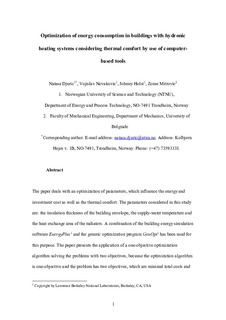| dc.contributor.author | Djuric, Natasa | |
| dc.contributor.author | Novakovic, Vojislav | |
| dc.contributor.author | Holst, Johnny N. | |
| dc.contributor.author | Mitrovic, Z | |
| dc.date.accessioned | 2019-01-21T14:46:24Z | |
| dc.date.available | 2019-01-21T14:46:24Z | |
| dc.date.created | 2007-11-27T09:55:27Z | |
| dc.date.issued | 2007 | |
| dc.identifier.citation | Energy and Buildings. 2007, 39 (4), 471-477. | nb_NO |
| dc.identifier.issn | 0378-7788 | |
| dc.identifier.uri | http://hdl.handle.net/11250/2581621 | |
| dc.description.abstract | The paper deals with an optimization of parameters, which influence the energy and investment cost as well as the thermal comfort. The parameters considered in this study are: the insulation thickness of the building envelope, the supply-water temperature and the heat exchange area of the radiators. A combination of the building energy simulation software EnergyPlus1 and the generic optimization program GenOpt (see footnote 1) has been used for this purpose. The paper presents the application of a one-objective optimization algorithm solving the problems with two objectives, because the optimization algorithm is one-objective and the problem has two objectives, which are minimal total costs and satisfied thermal comfort. The total costs represent the sum of energy consumption and the investment costs. The thermal comfort is represented by Predicted Percentage of Dissatisfied (PPD) in this study. The optimization is used to determine the values of parameters that give the lowest sum of investment and energy cost, under the condition that the thermal comfort is satisfied. In addition, the optimization processes show the mutual influence of parameters on both the total cost and the thermal comfort. | nb_NO |
| dc.language.iso | eng | nb_NO |
| dc.publisher | Elsevier | nb_NO |
| dc.rights | Attribution-NonCommercial-NoDerivatives 4.0 Internasjonal | * |
| dc.rights.uri | http://creativecommons.org/licenses/by-nc-nd/4.0/deed.no | * |
| dc.title | Optimization of energy consumption in buildings with hydronic heating systems considering thermal comfort by use of computer-based tools | nb_NO |
| dc.type | Journal article | nb_NO |
| dc.type | Peer reviewed | nb_NO |
| dc.description.version | acceptedVersion | nb_NO |
| dc.source.pagenumber | 471-477 | nb_NO |
| dc.source.volume | 39 | nb_NO |
| dc.source.journal | Energy and Buildings | nb_NO |
| dc.source.issue | 4 | nb_NO |
| dc.identifier.doi | 10.1016/j.enbuild.2006.08.009 | |
| dc.identifier.cristin | 369186 | |
| dc.description.localcode | © 2006. This is the authors’ accepted and refereed manuscript to the article. Locked until DATO due to copyright restrictions. This manuscript version is made available under the CC-BY-NC-ND 4.0 license http://creativecommons.org/licenses/by-nc-nd/4.0/ | nb_NO |
| cristin.unitcode | 194,64,25,0 | |
| cristin.unitname | Institutt for energi- og prosessteknikk | |
| cristin.ispublished | true | |
| cristin.fulltext | postprint | |
| cristin.qualitycode | 2 | |

